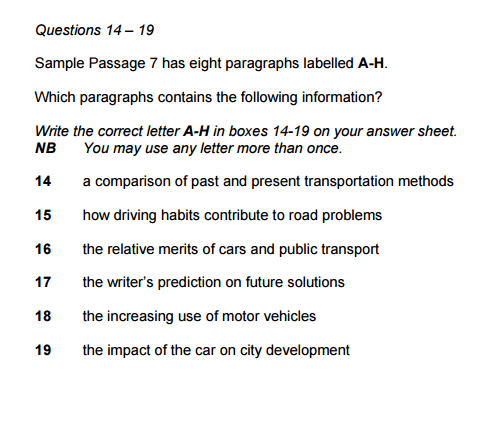Matching Information to Paragraphs
In this kind of question, you are asked to match statements to paragraphs in the reading text. Click here for an example.
The statements could be reasons, descriptions, summaries, definitions, facts or explanations. What they are doesn’t really matter. You are not expected to have specialist knowledge in the reading test.
You do not need to understand what the whole paragraph is about, just find specific information in the paragraph and match it to one of the statements. The answer will normally be contained in a whole phrase or sentence, rather than a single word.
This post will:
- look at an example
- identify the three reading skills required
- discuss common problems
- give you some tips
- provide you with a strategy to use
Example
Source: Cambridge English IELTS Past Papers.
This question is taken from an academic sample paper. As you can see, you are given a number of statements and you are required to match these to the correct paragraphs in the reading text.
The paragraphs in the reading text are labelled a, b, c, d and so on. Your answer will be the letter of the paragraph, not the words or phrases in the paragraph.
There will normally be more paragraphs than questions, so don’t worry if some of the paragraphs do not contain the information you are looking for. Also, don’t worry if you find more than one answer in one paragraph.
The answers do not appear in the same order as the questions.
Reading Skills
You will first have to be able to skim the reading text to get a general meaning of each paragraph.
You will also have to scan for specific words within the paragraphs. It is more likely that you will be looking for synonyms (different words that mean the same or nearly the same) and paraphrases rather than keywords from the question statements.
When you have found the words or phrases you think might give you the correct answer, you have to read very carefully in order to fully understand the meaning to be able to decide if it is really the correct answer.
Common Problems
The biggest problem is the fact that you need to look at the whole text. The answers could be anywhere in the text and they do not come in order, so it takes time.
Also, the answers might not be the main idea of each paragraph. Normally paragraphs contain one main idea and reading the first and last lines of the paragraph can help you understand this. With these questions, the answer could be in any part of the paragraph and you cannot therefore just quickly skim to find it.
There is also lots of irrelevant information that you do not need to consider. The strategy below will help you ignore much of this irrelevant information.
Finally, as stated above, not all paragraphs contain an answer and some paragraphs contain more than one answer.
Tips
- Do this question last. If you do other questions first, you will become familiar with the passage and this will help you identify the correct information more quickly and easily.
- Try to find names, place names and numbers in the questions. These are often easier to find in the text.
- Be aware that there may be synonyms. For example, you might see ‘34%‘ in the question but it might say ‘just over a third‘ or ‘about a third‘ in the text.
Strategy
This is my suggested strategy. There are many different strategies and you should use the one you feel comfortable with. You can also adapt this strategy to what suits you.
- Read the instructions carefully.
- Read the questions first. Think about synonyms and how you could paraphrase the statements. This will help you identify the answer. Saying each statement in your own words can help do this.
- Quickly skim the reading text to try to understand the general meaning of the text.
- Read the question statements again and predict which paragraph contains the answer.
- Scan the text paragraphs you think might contain the answer for synonyms. If you find a possible answer underline it.
- Check back with the question statement and mark the answer if correct. If not, move on to other paragraphs.
I hope you found this useful. If you have any questions please let me know in the comments below or on the Facebook page.

